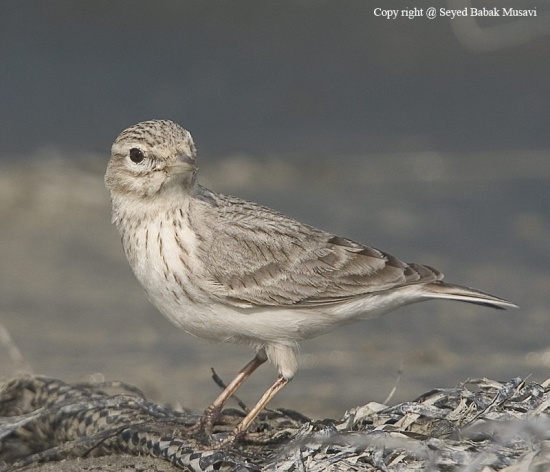| Line 1: | Line 1: | ||
| + | [[category:incomplete]] | ||
;Calandrella raytal | ;Calandrella raytal | ||
| − | [[Image:Indian_Short-toed_Lark.jpg|thumb|550px|right|Photo by Seyed Babak Mus]] | + | [[Image:Indian_Short-toed_Lark.jpg|thumb|550px|right|Photo by Seyed Babak Mus <br/> Location: near to shore in Soorgalm creek]] |
| + | |||
==Identification== | ==Identification== | ||
| − | + | 13cm. Greyish sandy, with dark brown streaks, from above, while the belly is white, sparsely and indistinctly dark-streaked on the sides. Supercilium and cheeks are white. Shortish black and white tail. Sexes alike. | |
| − | |||
| − | |||
==Distribution== | ==Distribution== | ||
| − | + | [[India]] | |
| − | |||
| − | |||
==Taxonomy== | ==Taxonomy== | ||
| Line 14: | Line 12: | ||
==Behaviour== | ==Behaviour== | ||
| − | + | ||
| − | + | Diet includes weed, seeds and insects. | |
| − | + | ||
| − | Nest: A cup like depression in the ground at the base of a shrub, lined with grass, hair, etc. | + | Nesting Season: February to May. Nest: A cup like depression in the ground at the base of a shrub, lined with grass, hair, etc. Eggs: 3, sometimes 2. Yellowish or greyish white, freckled with brown. Both sexes share domestic chores. |
| − | Eggs: 3, sometimes 2. Yellowish or greyish white, freckled with brown. | ||
| − | Both sexes share domestic chores. | ||
Revision as of 16:32, 3 October 2007
- Calandrella raytal
Identification
13cm. Greyish sandy, with dark brown streaks, from above, while the belly is white, sparsely and indistinctly dark-streaked on the sides. Supercilium and cheeks are white. Shortish black and white tail. Sexes alike.
Distribution
Taxonomy
Habitat
Behaviour
Diet includes weed, seeds and insects.
Nesting Season: February to May. Nest: A cup like depression in the ground at the base of a shrub, lined with grass, hair, etc. Eggs: 3, sometimes 2. Yellowish or greyish white, freckled with brown. Both sexes share domestic chores.




